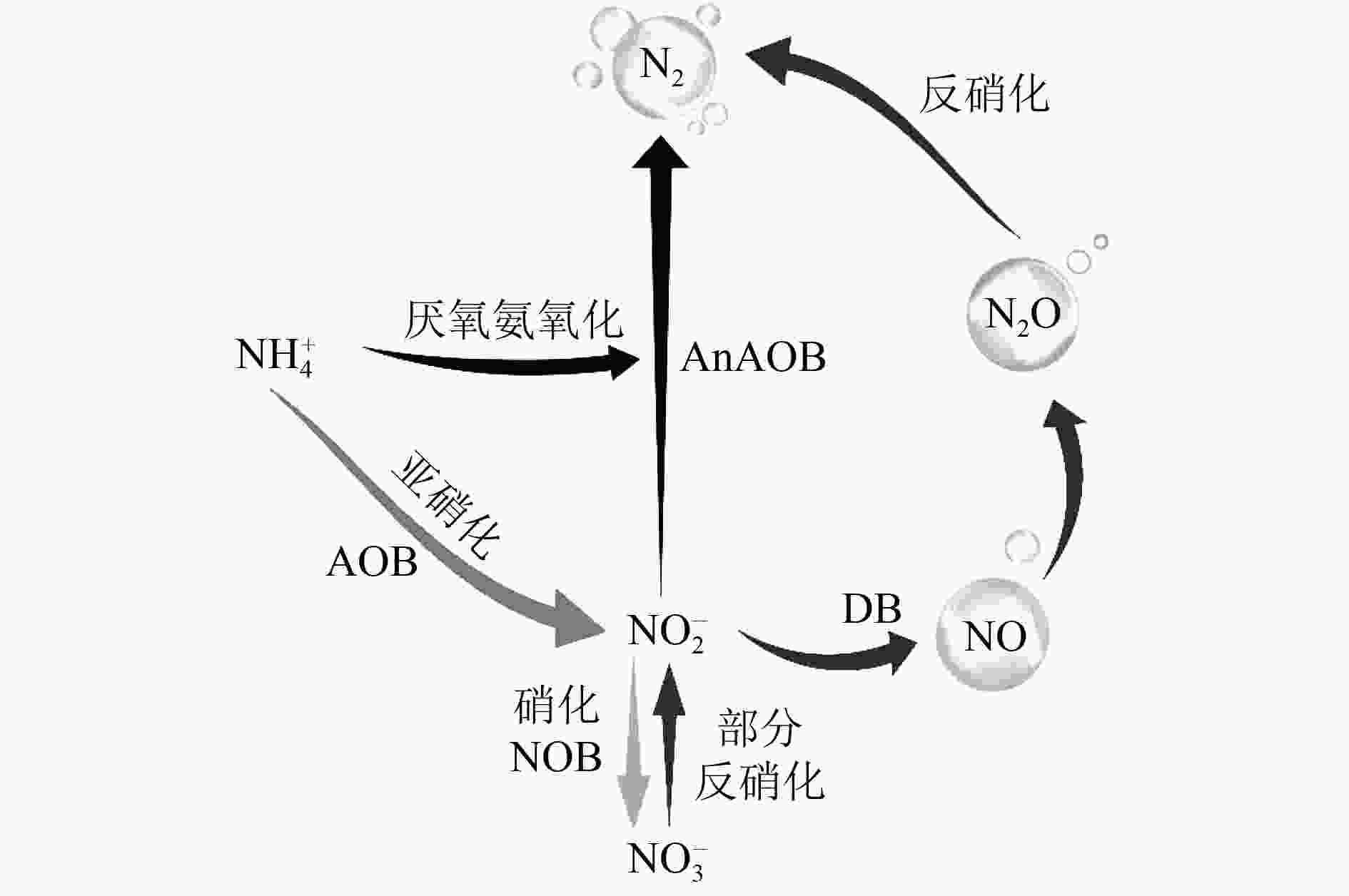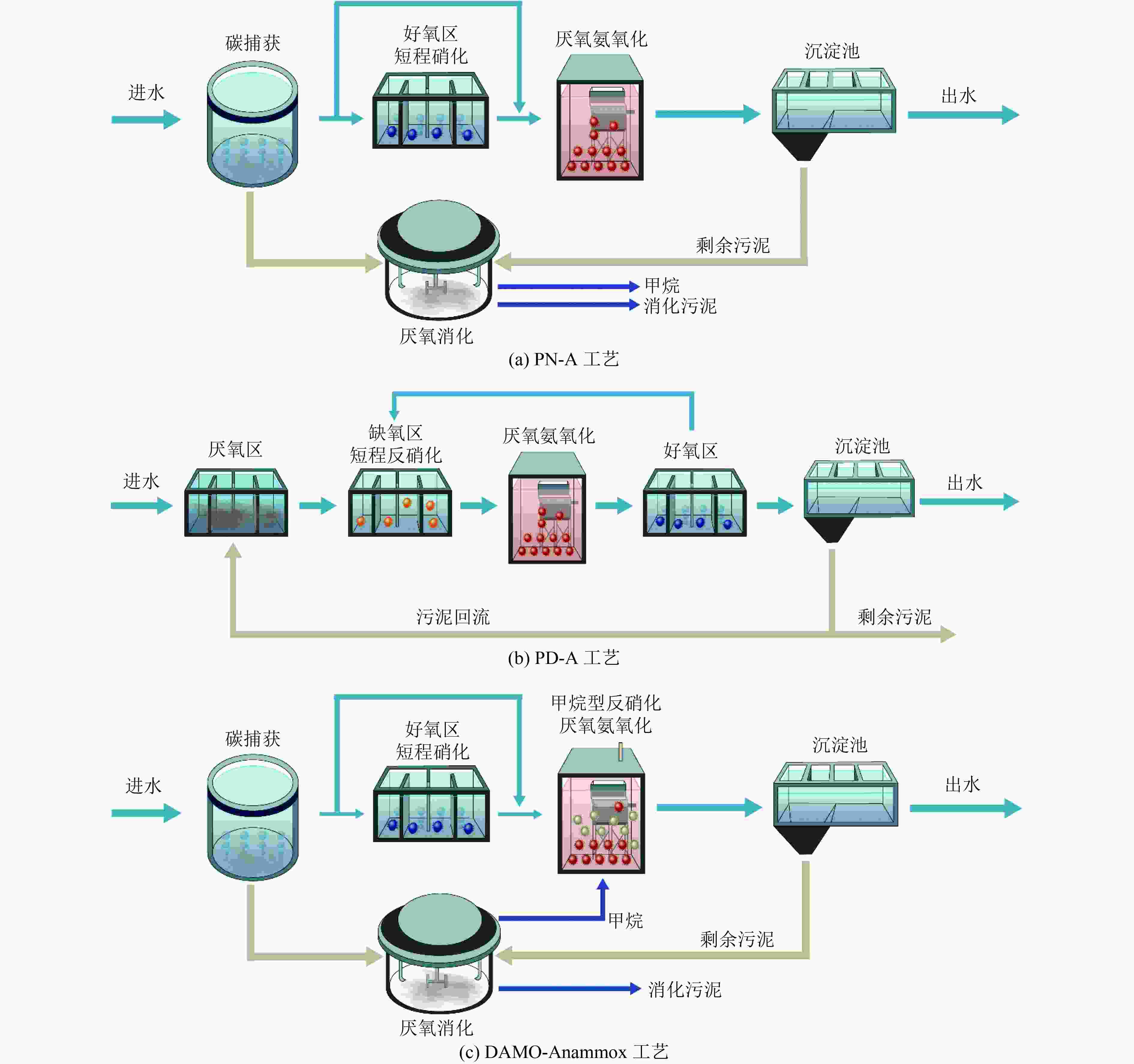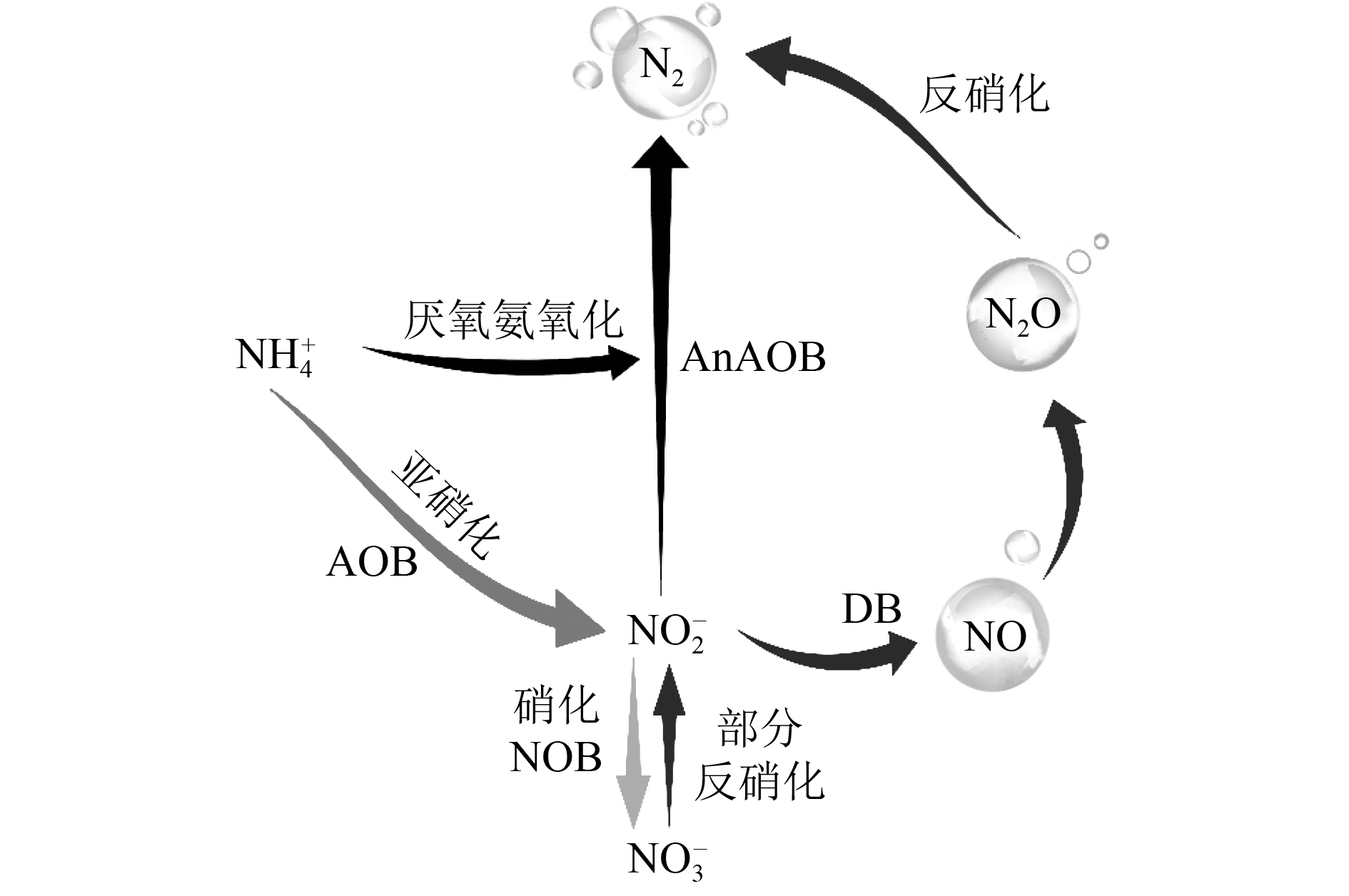Advances in application and reinforced control of Anammox nitrogen removal process based on carbon emission reduction
-
摘要:
随着我国“双碳”目标的提出和水处理行业提标改造的重点落在生物脱氮,污水处理厂从关注满足排放许可限制转向实现碳中和、能量自给及资源回收。厌氧氨氧化(Anammox)技术凭借无需外加有机碳源、占地面积小、污泥产量少以及脱氮效率高等节能降耗与碳减排优势,代表着未来污水生物脱氮的发展方向。基于已有研究成果,梳理对比了传统脱氮与Anammox反应的发展历程;重点综述了新兴短程硝化耦合Anammox(PN-A)工艺、短程反硝化耦合Anammox(PD-A)工艺和甲烷型反硝化耦合Anammox(DAMO-Anammox)工艺在城市主流工况的应用进展;详细探讨了主流Anammox工艺面临低温、进水负荷不均和光照等环境因素冲击时,可施行的“侧流污泥补充至主流”“侧流污水间歇性补充至主流”“驯化生物膜颗粒”等内源性以及外源性的强化调控策略及内在机制;最后围绕分子生物学技术、材料科学、数字信息技术和管理政策,对加快Anammox生物脱氮技术的创新发展与推广应用进行了展望。
-
关键词:
- 污水处理厂 /
- 厌氧氨氧化(Anammox) /
- 碳减排技术 /
- 强化调控 /
- 生物脱氮
Abstract:With the proposal of China's "dual carbon" goal and the focus of upgrading the water treatment industry to biological nitrogen removal, sewage treatment plants have shifted from focusing on meeting emission permit limits to realizing carbon neutrality, energy self-sufficiency and resource recovery potential. Anaerobic ammonia oxidation (Anammox) technology, with the advantages of no additional organic carbon source, small footprint, small sludge production and high nitrogen removal efficiency, represents the future development direction of biological nitrogen removal in sewage, with energy saving, consumption reduction and carbon emission reduction. Based on the existing research results, the discovery history of traditional nitrogen removal and Anammox reaction was summarized and compared. The application progress of emerging partial nitrification and Anammox (PN-A), partial denitrification and Anammox (PD-A), and anaerobic methane denitrification and Anammox (DAMO-Anammox) processes in urban mainstream conditions were reviewed. The endogenous and exogenous regulation strategies and their internal mechanisms, which could be implemented when the mainstream Anammox process was confronted with environmental factors such as low temperature, uneven influent load and light, were explored in detail. These strategies include "side-flow sludge supplement to mainstream" "side-flow sewage intermittent supplement to mainstream" and "acclimated biofilm particles", and so so on. Finally, future directions for accelerating the innovative development and application of Anammox nitrogen removal technology were proposed in terms of molecular biology technology, material sciences, digital information technology, and management policies.
-
表 1 厌氧氨氧化活性强化调控手段
Table 1. Activity enhancement means of Anammox process
生物强化途径 操作方式 强化机理 数据来源 内源性 侧流污泥补充至主流 提高菌种质量与丰度 文献[57] 侧流污水间歇性补充至主流 强化菌体合成代谢适应性 文献[59] 驯化生物膜颗粒 提供附着生长场所,形成内部厌氧环境,提高菌种丰度 文献[62] 外源性 外加无机碳 实现pH缓冲并提供充足碳源 文献[67] 添加酵母提取物 提供氨基酸等微量元素 文献[68] 添加铁基材料(零价铁、铁离子) 降低氧化还原电位促进颗粒化 文献[69] 添加导电材料(氧化石墨烯、碳纤维刷) 促进电子传递 文献[70-71] 施加物理场(电场、磁场、超声波) 改变细胞膜通透性并增强AnAOB酶的活性 文献[72] 培养菌藻共生体 联合脱氮促进菌群团聚 文献[73-75] 注:强化调控手段重点针对主流厌氧氨氧化工艺。 -
[1] 黄润秋. 把碳达峰碳中和纳入生态文明建设整体布局[J]. 环境经济,2021(22):12-15.HUANG R Q. Incorporate peak carbon dioxide emissions's carbon neutrality into the overall layout of ecological civilization construction[J]. Environmental Economy,2021(22):12-15. [2] 郝晓地, 张健. 污水处理的未来: 回归原生态文明[J]. 中国给水排水,2015,31(20):1-7.HAO X D, ZHANG J. Future of wastewater treatment: returning to originally ecological civilization[J]. China Water & Wastewater,2015,31(20):1-7. [3] 宋新新, 林甲, 刘杰, 等. 面向未来的污水处理厂关键技术研发与工程实践专栏序言[J]. 环境科学学报,2022,42(4):1-6. doi: 10.13671/j.hjkxxb.2021.0593SONG X X, LIN J, LIU J, et al. The R & D and practice of key technologies for sewage treatment plants facing the future[J]. Acta Scientiae Circumstantiae,2022,42(4):1-6. doi: 10.13671/j.hjkxxb.2021.0593 [4] 杨庆, 王亚鑫, 曹效鑫, 等. 污水处理碳中和运行技术研究进展[J]. 北京工业大学学报, 2022, 48(3): 292-305.YANG Q,WANG Y,CAO X,et alResearch progress of carbon neutrality operation technology in sewage treatment[J]. Journal of Beijing University of Technology,2022,48(3):292-305. [5] HAO X D, LIU R B, HUANG X. Evaluation of the potential for operating carbon neutral WWTPs in China[J]. Water Research,2015,87:424-431. doi: 10.1016/j.watres.2015.05.050 [6] 薛意, 陈荣, 邢保山, 等. 厌氧氨氧化: 理论和工艺发展概述(代序言)[J]. 环境工程学报,2022,16(2):375-380.XUE Y, CHEN R, XING B S, et al. Anaerobic ammonia oxidation: overview of theory and process development (preface)[J]. Chinese Journal of Environmental Engineering,2022,16(2):375-380. [7] KLOTZ M G, STEIN L Y. Nitrifier genomics and evolution of the nitrogen cycle[J]. FEMS Microbiology Letters,2008,278(2):146-156. doi: 10.1111/j.1574-6968.2007.00970.x [8] KAMPSCHREUR M J, TAN N C G, KLEEREBEZEM R, et al. Effect of dynamic process conditions on nitrogen oxides emission from a nitrifying culture[J]. Environmental Science & Technology,2008,42(2):429-435. [9] HELLINGA C, SCHELLEN A A J C, MULDER J W, et al. The Sharon process: an innovative method for nitrogen removal from ammonium-rich waste water[J]. Water Science and Technology,1998,37(9):135-142. doi: 10.2166/wst.1998.0350 [10] VERSTRAETE W, PHILIPS S. Nitrification-denitrification processes and technologies in new contexts[J]. Environmental Pollution,1998,102(1):717-726. doi: 10.1016/S0269-7491(98)80104-8 [11] 高静. 短程反硝化影响因素优化及耦合厌氧氨氧化深度脱氮性能研究[D]. 扬州: 扬州大学, 2023. [12] 郝晓地, 杨万邦, 李季, 等. 厌氧氨氧化技术研究与应用反差现象归因[J]. 环境科学学报,2023,43(9):1-13. doi: 10.13671/j.hjkxxb.2023.0256HAO X D, YANG W B, LI J, et al. Attribution of the contrast phenomena of ANAMMOX techniques on research and application[J]. Acta Scientiae Circumstantiae,2023,43(9):1-13. doi: 10.13671/j.hjkxxb.2023.0256 [13] BRODA E. Two kinds of lithotrophs missing in nature[J]. Zeitschrift Fur Allgemeine Mikrobiologie,1977,17(6):491-493. doi: 10.1002/jobm.19770170611 [14] KUENEN J G. Anammox bacteria: from discovery to application[J]. Nature Reviews Microbiology,2008,6(4):320-326. doi: 10.1038/nrmicro1857 [15] van der STAR W R L, ABMA W R, BLOMMERS D, et al. Startup of reactors for anoxic ammonium oxidation: experiences from the first full-scale anammox reactor in Rotterdam[J]. Water Research,2007,41(18):4149-4163. doi: 10.1016/j.watres.2007.03.044 [16] KUMAR M, LIN J G. Co-existence of anammox and denitrification for simultaneous nitrogen and carbon removal: strategies and issues[J]. Journal of Hazardous Materials,2010,178(1/2/3):1-9. [17] TANG C J, ZHENG P, WANG C H, et al. Performance of high-loaded ANAMMOX UASB reactors containing granular sludge[J]. Water Research,2011,45(1):135-144. doi: 10.1016/j.watres.2010.08.018 [18] CAO Y S, van LOOSDRECHT M C M, DAIGGER G T. Mainstream partial nitritation-anammox in municipal wastewater treatment: status, bottlenecks, and further studies[J]. Applied Microbiology and Biotechnology,2017,101(4):1365-1383. doi: 10.1007/s00253-016-8058-7 [19] PAN Y, LIU D F. Tapping the potential of wastewater treatment with direct ammonia oxidation (dirammox)[J]. Environmental Science & Technology,2023,57(18):7106-7108. [20] LACKNER S, GILBERT E M, VLAEMINCK S E, et al. Full-scale partial nitritation/anammox experiences: an application survey[J]. Water Research,2014,55:292-303. doi: 10.1016/j.watres.2014.02.032 [21] JIN P F, LI B K, MU D Y, et al. High-efficient nitrogen removal from municipal wastewater via two-stage nitritation/anammox process: long-term stability assessment and mechanism analysis[J]. Bioresource Technology,2019,271:150-158. doi: 10.1016/j.biortech.2018.09.097 [22] TCHOBANOGLOUS G, BURTON F L, STENSEL H D. Wastewater engineering: treatment and reuse[M]. 4th ed. Boston: McGraw-Hill, 2003. [23] JIMENEZ J, MILLER M, BOTT C, et al. High-rate activated sludge system for carbon management: evaluation of crucial process mechanisms and design parameters[J]. Water Research,2015,87:476-482. doi: 10.1016/j.watres.2015.07.032 [24] DIAMANTIS V, VERSTRAETE W, EFTAXIAS A, et al. Sewage pre-concentration for maximum recovery and reuse at decentralized level[J]. Water Science and Technology,2013,67(6):1188-1193. doi: 10.2166/wst.2013.639 [25] LI X J, SUN S, YUAN H Y, et al. Mainstream upflow nitritation-anammox system with hybrid anaerobic pretreatment: long-term performance and microbial community dynamics[J]. Water Research,2017,125:298-308. doi: 10.1016/j.watres.2017.08.048 [26] CAO S B, KOCH K, DREWES J E, et al. Re-evaluating the necessity of high-rate activated sludge processes for mainstream anammox[J]. Environmental Science & Technology,2023,57(5):1851-1854. [27] JOSS A, DERLON N, CYPRIEN C, et al. Combined nitritation–anammox: advances in understanding process stability[J]. Environmental Science & Technology,2011,45(22):9735-9742. [28] DU R, PENG Y Z, JI J T, et al. Partial denitrification providing nitrite: opportunities of extending application for anammox[J]. Environment International,2019,131:105001. doi: 10.1016/j.envint.2019.105001 [29] SHI Y, HU S H, LOU J Q, et al. Nitrogen removal from wastewater by coupling anammox and methane-dependent denitrification in a membrane biofilm reactor[J]. Environmental Science & Technology,2013,47(20):11577-11583. [30] GONZALEZ-MARTINEZ A, MORILLO J A, GARCIA-RUIZ M J, et al. Archaeal populations in full-scale autotrophic nitrogen removal bioreactors operated with different technologies: CANON, DEMON and partial nitritation/anammox[J]. Chemical Engineering Journal,2015,277:194-201. doi: 10.1016/j.cej.2015.04.137 [31] VEUILLET F, LACROIX S, BAUSSERON A, et al. Integrated fixed-film activated sludge ANITA™Mox process: a new perspective for advanced nitrogen removal[J]. Water Science and Technology,2014,69(5):915-922. doi: 10.2166/wst.2013.786 [32] AICHINGER P, WADHAWAN T, KUPRIAN M, et al. Synergistic co-digestion of solid-organic-waste and municipal-sewage-sludge: 1 plus 1 equals more than 2 in terms of biogas production and solids reduction[J]. Water Research,2015,87:416-423. doi: 10.1016/j.watres.2015.07.033 [33] CAO Y, HONG K B, YAN Z, et al. Mainstream partial nitritation/anammox nitrogen removal process in the largest water reclamation plant in Singapore[J]. Journal of Beijing University of Technology,2015,41(10):1441-1447. [34] 杜睿, 彭永臻. 城市污水生物脱氮技术变革: 厌氧氨氧化的研究与实践新进展[J]. 中国科学:技术科学,2022,52(3):389-402. doi: 10.1360/SST-2020-0407DU R, PENG Y Z. Technical revolution of biological nitrogen removal from municipal wastewater: recent advances in Anammox research and application[J]. Scientia Sinica (Technologica),2022,52(3):389-402. doi: 10.1360/SST-2020-0407 [35] 刘华光, 董文艺, 王宏杰, 等. 厌氧氨氧化在城市污水脱氮处理中的研究与应用进展[J]. 环境工程技术学报,2022,12(5):1508-1518.LIU H G, DONG W Y, WANG H J, et al. Research and application progress of anaerobic ammonia oxidation in denitrification of municipal sewage[J]. Journal of Environmental Engineering Technology,2022,12(5):1508-1518. [36] YIN T, CAO J, ZHANG T, et al. Research progress on nitrite accumulation during denitrification with different carbon sources[J]. Applied Chemical Industry,2020,49(11):2919-2925. [37] QIAN W T, MA B, LI X Y, et al. Long-term effect of pH on denitrification: high pH benefits achieving partial-denitrification[J]. Bioresource Technology,2019,278:444-449. doi: 10.1016/j.biortech.2019.01.105 [38] 常根旺, 杨津津, 李绍康, 等. 短程反硝化耦合厌氧氨氧化强化脱氮工艺研究与应用进展[J]. 环境工程技术学报,2022,12(5):1519-1527. doi: 10.12153/j.issn.1674-991X.20210578CHANG G W, YANG J J, LI S K, et al. Research and application progress of partial denitrification coupled with anammox for enhanced denitrification[J]. Journal of Environmental Engineering Technology,2022,12(5):1519-1527. doi: 10.12153/j.issn.1674-991X.20210578 [39] LI J W, PENG Y Z, ZHANG L, et al. Quantify the contribution of anammox for enhanced nitrogen removal through metagenomic analysis and mass balance in an anoxic moving bed biofilm reactor[J]. Water Research,2019,160:178-187. doi: 10.1016/j.watres.2019.05.070 [40] GAO R T, PENG Y Z, LI J W, et al. Improving performance and efficiency of partial anammox by coupling partial nitrification and partial denitrification (PN/A-PD/A) to treat municipal sewage in a step-feed reactor[J]. Bioresource Technology,2021,341:125804. doi: 10.1016/j.biortech.2021.125804 [41] LI X C, PENG Y Z, ZHANG J W, et al. Highly efficient and synchronous nitrogen removal from ammonia-rich wastewater and domestic wastewater via a novel anammox coupled with double-nitrite-shunt process at low temperature[J]. Chemical Engineering Journal,2021,425:131449. doi: 10.1016/j.cej.2021.131449 [42] ALI P, ZALIVINA N, LE T, et al. Primary sludge fermentate as carbon source for mainstream partial denitrification-anammox (PdNA)[J]. Water Environment Research: a Research Publication of the Water Environment Federation, 2021, 93(7): 1044-1059. [43] ZHAO Q, CHEN K Q, LI J W, et al. Pilot-scale evaluation of partial denitrification/anammox on nitrogen removal from low COD/N real sewage based on a modified process[J]. Bioresource Technology,2021,338:125580 [44] HAROON M F, HU S H, SHI Y, et al. Anaerobic oxidation of methane coupled to nitrate reduction in a novel archaeal lineage[J]. Nature,2013,500(7464):567-570. doi: 10.1038/nature12375 [45] 张福凯, 徐龙君. 甲烷对全球气候变暖的影响及减排措施[J]. 矿业安全与环保,2004,31(5):6-9. doi: 10.3969/j.issn.1008-4495.2004.05.003ZHANG F K, XU L J. Effect of methane on global warming and mitigating measures[J]. Mining Safety & Environmental Protection,2004,31(5):6-9. doi: 10.3969/j.issn.1008-4495.2004.05.003 [46] FAN S Q, WEN W R, XIE G J, et al. Deep insights into the population shift of n-DAMO and Anammox in granular sludge: from sidestream to mainstream[J]. Water Research,2023,244:120448. doi: 10.1016/j.watres.2023.120448 [47] AL-HAZMI H E, MAKTABIFARD M, GRUBBA D, et al. An advanced synergy of partial denitrification-anammox for optimizing nitrogen removal from wastewater: a review[J]. Bioresource Technology,2023,381:129168. doi: 10.1016/j.biortech.2023.129168 [48] MA G C, YU D S, ZHANG J H, et al. A novel simultaneous partial nitrification, anammox, denitrification and fermentation process: enhancing nitrogen removal and sludge reduction in a single reactor[J]. Bioresource Technology,2023,369:128484. doi: 10.1016/j.biortech.2022.128484 [49] CHEN Y J, FENG G, GUO G Z, et al. Improved properties and enhancement strategies of hydroxyapatite-based functional granular sludge for a high-rate partial nitritation/anammox system[J]. Environmental Science & Technology,2023,57(19):7624-7633. [50] MULDER A, van de GRAAF A A, ROBERTSON L A, et al. Anaerobic ammonium oxidation discovered in a denitrifying fluidized bed reactor[J]. FEMS Microbiology Ecology,1995,16(3):177-183. doi: 10.1111/j.1574-6941.1995.tb00281.x [51] JIN R C, YANG G F, YU J J, et al. The inhibition of the Anammox process: a review[J]. Chemical Engineering Journal,2012,197:67-79. doi: 10.1016/j.cej.2012.05.014 [52] OLSSON G. ICA and me: a subjective review[J]. Water Research,2012,46(6):1585-1624. doi: 10.1016/j.watres.2011.12.054 [53] 魏彩莹, 张静, 任露露, 等. 厌氧氨氧化活性抑制、恢复与强化及工艺应用研究进展[J]. 应用与环境生物学报,2018,24(3):671-680.WEI C Y, ZHANG J, REN L L, et al. Recent advances in activity inhibition, recovery and enhancement, and application of the anaerobic ammonium oxidation process[J]. Chinese Journal of Applied and Environmental Biology,2018,24(3):671-680. [54] ANTHONISEN A C, LOEHR R C, PRAKASAM T B, et al. Inhibition of nitrification by ammonia and nitrous acid[J]. Journal-Water Pollution Control Federation,1976,48(5):835-852. [55] XIE J, JIANG Y, CHANG Y, et al. Research progress of anaerobic ammonia oxidation treatment of urban sewage[J]. Chemical Industry and Engineering Progress,2020,39(10):4175-4184. [56] LAURENI M, FALÅS P, ROBIN O, et al. Mainstream partial nitritation and anammox: long-term process stability and effluent quality at low temperatures[J]. Water Research,2016,101:628-639. doi: 10.1016/j.watres.2016.05.005 [57] WETT B, OMARI A, PODMIRSEG S M, et al. Going for mainstream deammonification from bench to full scale for maximized resource efficiency[J]. Water Science and Technology,2013,68(2):283-289. doi: 10.2166/wst.2013.150 [58] WETT B, PODMIRSEG S M, GÓMEZ-BRANDÓN M, et al. Expanding DEMON sidestream deammonification technology towards mainstream application[J]. Water Environment Research:a Research Publication of the Water Environment Federation,2015,87(12):2084-2089. doi: 10.2175/106143015X14362865227319 [59] CHEN Z J, MENG F G, ZHOU C Y, et al. Optimum relative frequency and fluctuating substrate selection in reinforcing anammox-mediated anabolic adaptation[J]. Water Research,2023,228:119377. doi: 10.1016/j.watres.2022.119377 [60] 王伟刚, 王彤, 樊宇菲, 等. 厌氧氨氧化颗粒污泥聚集机制研究进展[J]. 微生物学通报,2022,49(5):1927-1940. doi: 10.13344/j.microbiol.china.210893WANG W G, WANG T, FAN Y F, et al. Research progress on the aggregation mechanism of anammox granular sludge[J]. Microbiology China,2022,49(5):1927-1940. doi: 10.13344/j.microbiol.china.210893 [61] MANONMANI U, JOSEPH K. Granulation of anammox microorganisms for autotrophic nitrogen removal from wastewater[J]. Environmental Chemistry Letters,2018,16(3):881-901. doi: 10.1007/s10311-018-0732-9 [62] FERNÁNDEZ I, VÁZQUEZ-PADÍN J R, MOSQUERA-CORRAL A, et al. Biofilm and granular systems to improve Anammox biomass retention[J]. Biochemical Engineering Journal,2008,42(3):308-313. doi: 10.1016/j.bej.2008.07.011 [63] GILBERT E M, AGRAWAL S, KARST S M, et al. Low temperature partial nitritation/anammox in a moving bed biofilm reactor treating low strength wastewater[J]. Environmental Science & Technology,2014,48(15):8784-8792. [64] LI X J, FENG Y M, ZHANG K, et al. Composite carrier enhanced bacterial adhesion and nitrogen removal in partial nitrification/anammox process[J]. Science of the Total Environment,2023,868:161659. doi: 10.1016/j.scitotenv.2023.161659 [65] WU J, KONG Z, LUO Z B, et al. A successful start-up of an anaerobic membrane bioreactor (AnMBR) coupled mainstream partial nitritation-anammox (PN/A) system: a pilot-scale study on in-situ NOB elimination, AnAOB growth kinetics, and mainstream treatment performance[J]. Water Research,2021,207:117783. doi: 10.1016/j.watres.2021.117783 [66] NI L F, WANG K C, WANG Z W, et al. Antibiofouling characteristics and mechanisms in an anammox membrane bioreactor based on an optimized photocatalytic technology-photocatalytic optical fibers[J]. Environmental Science & Technology,2022,56(22):16144-16155. [67] JIN R C, YU J J, MA C, et al. Transient and long-term effects of bicarbonate on the ANAMMOX process[J]. Applied Microbiology and Biotechnology,2014,98(3):1377-1388. doi: 10.1007/s00253-013-5004-9 [68] van der STAR W R L, MICLEA A I, van DONGEN U G J M, et al. The membrane bioreactor: a novel tool to grow anammox bacteria as free cells[J]. Biotechnology and Bioengineering,2008,101(2):286-294. doi: 10.1002/bit.21891 [69] ZHANG Y B, AN X L, QUAN X. Enhancement of sludge granulation in a zero valence iron packed anaerobic reactor with a hydraulic circulation[J]. Process Biochemistry,2011,46(2):471-476. doi: 10.1016/j.procbio.2010.09.021 [70] TOMASZEWSKI M, CEMA G, CIESIELSKI S, et al. Cold anammox process and reduced graphene oxide: varieties of effects during long-term interaction[J]. Water Research,2019,156:71-81. doi: 10.1016/j.watres.2019.03.006 [71] FENG K, LOU Y, LI Y T, et al. Conductive carrier promotes synchronous biofilm formation and granulation of anammox bacteria[J]. Journal of Hazardous Materials,2023,447:130754. doi: 10.1016/j.jhazmat.2023.130754 [72] 李天皓, 江雨婕, 毛蔚, 等. 厌氧氨氧化脱氮强化途径的研究进展[J]. 工业水处理,2022,42(7):7-14. doi: 10.19965/j.cnki.iwt.2021-0483LI T H, JIANG Y J, MAO W, et al. Research advance on enhanced approaches of Anammox-based nitrogen removal[J]. Industrial Water Treatment,2022,42(7):7-14. doi: 10.19965/j.cnki.iwt.2021-0483 [73] MANSER N D, WANG M, ERGAS S J, et al. Biological nitrogen removal in a photosequencing batch reactor with an algal-nitrifying bacterial consortium and anammox granules[J]. Environmental Science & Technology Letters,2016,3(4):175-179. [74] ZHANG B, LENS P N L, SHI W X, et al. Enhancement of aerobic granulation and nutrient removal by an algal-bacterial consortium in a lab-scale photobioreactor[J]. Chemical Engineering Journal,2018,334:2373-2382. doi: 10.1016/j.cej.2017.11.151 [75] KONG L R, ZHENG R, FENG Y M, et al. Anammox bacteria adapt to long-term light irradiation in photogranules[J]. Water Research,2023,241:120144. ⊗ doi: 10.1016/j.watres.2023.120144 -





 下载:
下载:



